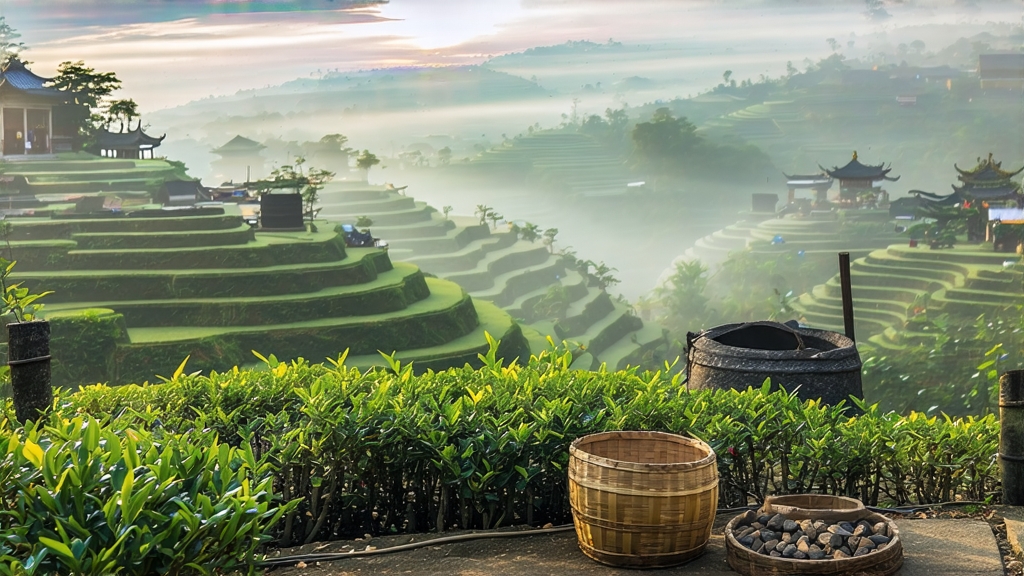
Tucked high above the Sichuan basin where humid clouds brush the shoulders of monks, Meng Ding Huang Ya has been quietly perfecting its golden hue for twelve centuries. International drinkers often greet “yellow tea” with a polite nod toward Keemun or a confused smile at jasmine, yet this bud-centric rarity once traveled in sedan chairs to the Tang emperor, its price fixed in bolts of silk. To understand why the leaf turns amber without ever touching fire, and why the cup tastes like warm apricot skin over limestone, we must follow the cool Sichuan mist from Qing dynasty ledgers back to the bamboo baskets still used today.
History: from palace secret to endangered art
Meng Ding Shan, “the misty summit,” rises 1 450 m at the western edge of the Sichuan red-basin; its year-round fog slows photosynthesis, stacking amino acids inside every axillary bud. A Buddhist monk named Gan Lu (“Sweet Dew”) is said to have planted the first seven bushes during the Han dynasty; by Tang times the tea was pressed into cakes and carried along the Jiannan Road to Chang-an. When Song emperors demanded loose leaf, local magistrates invented a slow oxidation step—wrapping the barely-dried buds in thick paper so that residual moisture “smolders” the leaf for 24 hours, turning it the color of antique parchment. The Qing court listed Meng Ding Huang Ya among the eight “fengji” tributes whose harvest day was dictated by astronomy; failure to deliver before the Dragon Boat Festival could cost a magistrate his queue. After 1949 the gardens were collectivized, the meticulous yellowing process judged too laborious; by 1980 only three old masters still remembered the full sequence. A 2003 UNESCO-GEF project traced surviving micro-plots, grafted 18 000 bushes, and re-established a 6-hectare demonstration garden. Today fewer than 3 000 kg of authentic Meng Ding Huang Ya reach the market each spring, most pre-sold to private collectors in Beijing and Tokyo.
Micro-terroir and cultivar
The traditional cultivar is a local broad-leaf Camellia sinensis var. sinensis locally called “xiao ye zhong” (small-leaf race). Grown on yellow-brown phyllite soils rich in selenium and zinc, the bushes sit just below the cloud belt at 1 200–1 400 m. Day-night temperature differentials average 9 °C, locking in linalool and geraniol precursors. Only the terminal bud and the first unfolding leaf, still fish-hook shaped, are plucked; the standard is 25 000 such sets per kilogram of finished tea.
Craft: the art of “sealed yellowing”
-
Withering under mist
Plucking starts at 05:30 when dew weight exceeds 8 %. Leaves are laid on bamboo trays set on mountain-side racks so that evaporative cooling lengthens the withering phase to 6–7 hours; enzymatic activity concentrates soluble sugars. -
Pan-fixation at 160 °C
A wok, brushed only with spring water, receives 250 g of leaf per toss. The master’s wrist rotates 18 times in 40 seconds, just enough to rupture marginal cells while keeping the bud intact. Moisture drops to 55 %. -
Rolling while warm
The still-hot leaf is wrapped in a square of hemp cloth and rolled diagonally across a rattan mat; pressure is calibrated to crease the leaf without breaking the bud tip—critical for the symmetrical “sparrow’s tongue” shape prized by inspectors. -
First drying over bamboo charcoal
Bundles are suspended 40 cm above a low charcoal fire (45 °C) for 20 minutes; the leaf surface dries, but internal moisture remains above 25 %. -
Sealed yellowing—the signature step
The half-dried leaf is piled 3 cm deep inside double-layered rice-paper sleeves, then slid into a wooden chest lined with cedar shavings. For 24–30 hours the chest stays in a cave-like chamber at 28 °C and 75 % RH. Polyphenol oxidase and peroxidase slowly re-activate, chlorophyll degrades to pheophytin, and flavonols oxidize, producing the golden liquor and distinctive “dui xiang” (stacked aroma) reminiscent of fresh straw, pumpkin blossom, and dried longan. The master checks every 3 hours